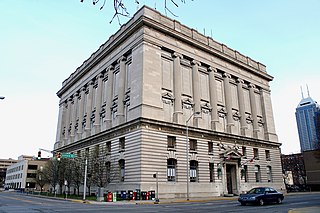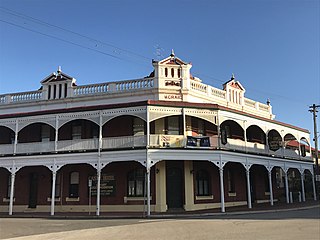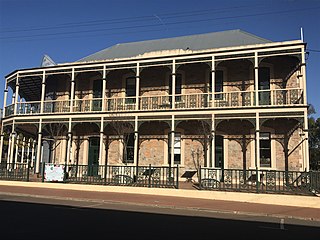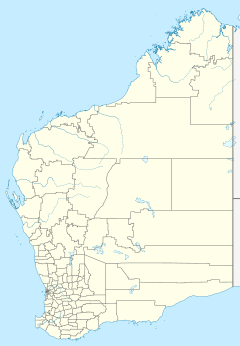
The Independent Order of Oddfellows Manchester Unity Friendly Society Limited, also called the Manchester Unity of Oddfellows; trading as The Oddfellows, is a fraternal order founded in Manchester in 1810.

York is the oldest inland town in Western Australia, situated on the Avon River, 97 kilometres (60 mi) east of Perth in the Wheatbelt, on Ballardong Nyoongar land, and is the seat of the Shire of York.

Freemasons' Hall in London is the headquarters of the United Grand Lodge of England and the Supreme Grand Chapter of Royal Arch Masons of England, as well as being a meeting place for many Masonic Lodges in the London area. It is located in Great Queen Street between Holborn and Covent Garden and has been a Masonic meeting place since 1775.

The current Indianapolis Masonic Temple, also known as Indiana Freemasons Hall, is a historic Masonic Temple located at Indianapolis, Indiana. Construction was begun in 1908, and the building was dedicated in May 1909. It is an eight-story, Classical Revival style cubic form building faced in Indiana limestone. The building features rows of engaged Ionic order columns. It was jointly financed by the Indianapolis Masonic Temple Association and the Grand Lodge of Free and Accepted Masons of Indiana, and was designed by the distinguished Indianapolis architectural firm of Rubush and Hunter.

The Masonic Hall is a grade II listed building on Monk Street in Monmouth, Monmouthshire, Wales. It was designed by architect George Vaughan Maddox. The building is believed to mark the site of Monk's Gate, part of the original defences of the town of Monmouth. Before its 1846 conversion to the Masonic Hall, the building served as the Monk Street Theatre. After more than 150 years of housing the Loyal Monmouth Lodge No. 457, the Masonic Hall sustained fire and smoke damage from suspected arson. The Lodge of Freemasons housed in the building is the oldest surviving Masonic Lodge in Monmouthshire.

York Town Hall is a heritage listed town hall in York, Western Australia, located in Avon Terrace. At the time of its construction, it was claimed to be the largest public hall in Western Australia, with an interior floor space measuring 100 by 50 feet.

Avon Terrace it is the main street of the town of York, Western Australia, and is lined with heritage buildings.
James William Wright was an Australian architect, civil engineer, and politician. He established the first private architectural practice in Western Australia in 1884, which now operates as Cameron Chisholm Nicol. Wright also served in the state's Legislative Council from 1902 to 1908, representing Metropolitan Province.

York Post Office, on Avon Terrace in York, Western Australia, is the oldest surviving two storey post and telegraph building in Western Australia, and forms part of the heritage-listed town centre complex with the Court House and Police Station (1895). The site has been continuously used as a post office since 1866. The York Post Office was built in response to the town's growing importance as a rural centre and as the town and railway centre closest to the goldfields in the Yilgarn during the initial period of the Western Australian gold rush.

Faversham House is a heritage-listed "grand residence" overlooking Avon Terrace in York, Western Australia. The house, named after the birthplace of John Henry Monger Snr, was built in four stages by the Monger family.

The Castle Hotel in York is one of the oldest surviving hotels in Western Australia. Its first proprietor was Samuel Craig and it was then held by members of the Craig family for 137 years.

The Imperial Hotel was the first hotel to be built in York, Western Australia that adopted the new "Australian hotel" style in hotel design, with a dominant position on a main street corner block, high and ornate double verandahs surrounding the façade and a main entrance onto the street. The building is in Victorian Filigree style.
John Henry Monger Snr (1802–1867) arrived in Western Australia as an assisted migrant in 1829. After a short period running a mill at what became Lake Monger, he established a hotel and store in York and went on to become one of the richest men in the colony.

The Suspension Bridge is a suspension foot bridge with steel cables and timber decking spanning the Avon River between Lowe Street and Pool Street, York, Western Australia, linking the commercial centre of the town with the Holy Trinity Church.

Settlers House is a historic hotel in the centre of York, Western Australia.

The Residency Museum in York, Western Australia is a single-storey, heritage-listed building in the Victorian Georgian style. It is associated with the also heritage-listed Old York Hospital.

The York Flour Mill is a purpose-built flour mill, constructed in 1892 with associated buildings built from 1892 onwards, to mill flour for York and the surrounding districts, and for export.

The Uniting Church, York, Western Australia and the former chapel are significant early buildings of York, Western Australia.
Joseph Pyke (1831-1910) was a shoemaker who settled in York, Western Australia in 1857 with his wife, Elizabeth, and became a prominent store keeper and land owner in the town, developing the first street-front shops, and taking a significant role in town affairs.

















